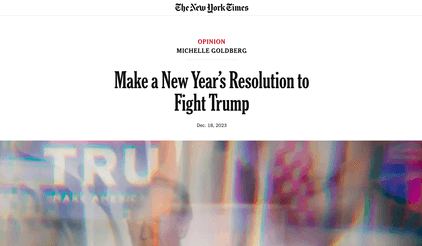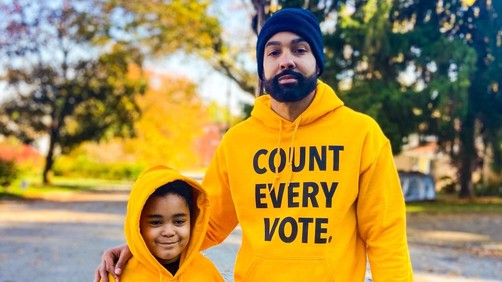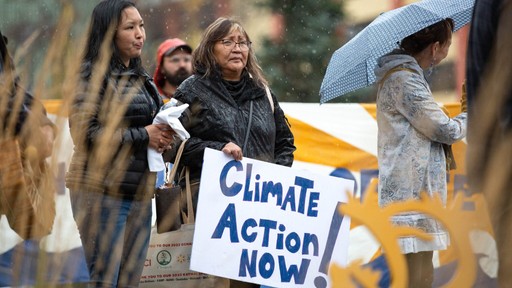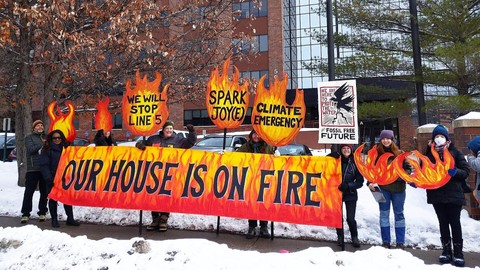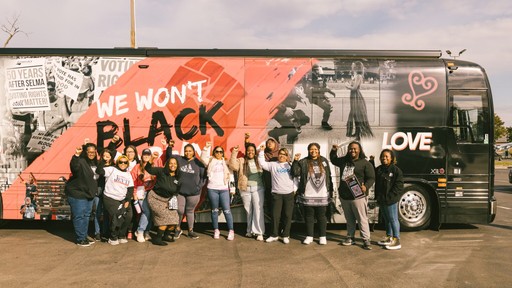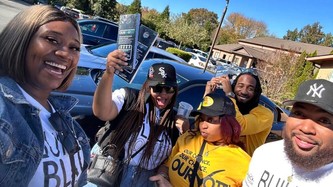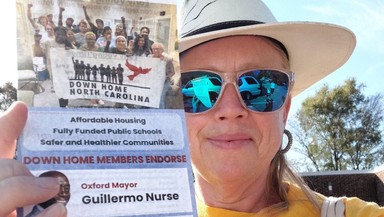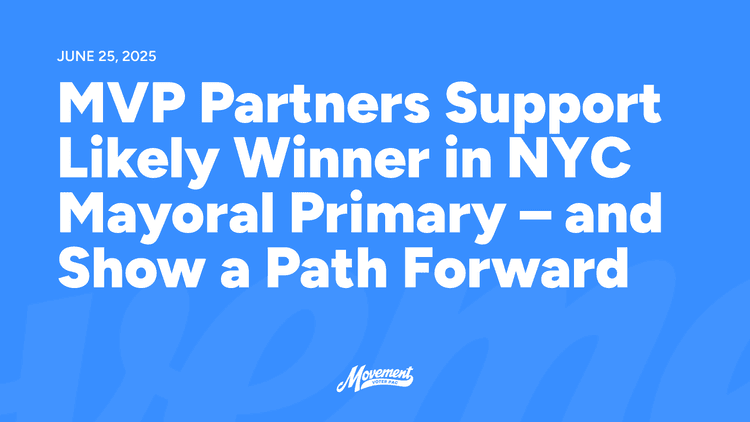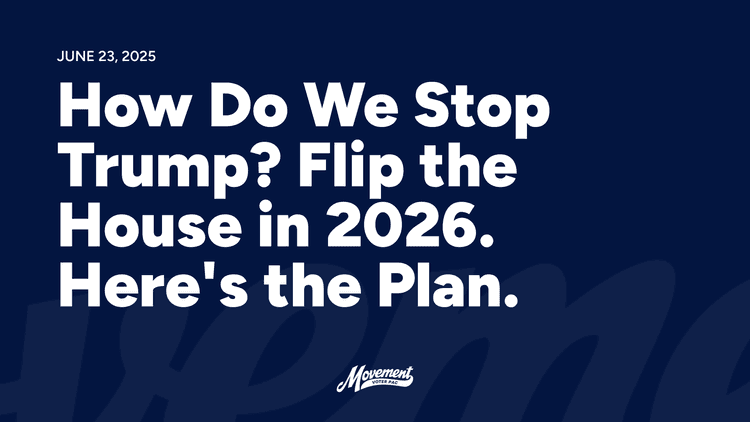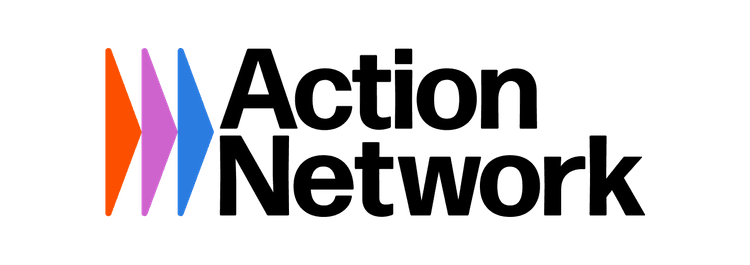Bat Signal 2: The Biggest Investment Ever

Credit: Living United for Change in Arizona (LUCHA)
Dear colleagues in progressive politics and philanthropy:
In September, I sent out a Bat Signal memo documenting the dangerous drought in funding for Democratic-aligned organizing in the lead-up to 2024. Throughout 2023, we witnessed a disturbing trend: progressive voter organizations laying off staff, tightening belts, and shelving programs. This was accompanied by an eerie lack of public attention. The Bat Signal memo was an attempt to alert donors to avert a five-alarm fire.
Since September, a LOT has happened. The utterly horrifying situation in Israel and Gaza has divided and depressed the Democratic base. Biden’s poll numbers have gone from bad to worse than Trump. Mike Johnson became the most extreme right-wing House speaker in modern history. Trump has gone full-throated fascist. We also won some really important elections that, going into 2024, gave us a shot of the renewed hope and momentum we have been desperately searching for.
I’ve been fascinated listening to our donors, some of whom, inspired in part by reading the Bat Signal, and in part by Trump’s increasingly Hitleresque rants, have felt compelled to make their biggest donations ever – including three donors who—completely unprompted—contacted my organization, Movement Voter PAC (MVP), to make $1 million donations.
In Bat Signal 2, I initially set out to tackle the deeper challenges and political dynamics we face. But the holiday break was coming. And I realized that the most important thing to write was something hopeful and actionable that people might feel inspired to discuss with their families over the holidays. Something that might move them to follow the lead of the first three spontaneous $1 million donors and consider making their biggest donations ever. Could we make this a trend and get a hundred people or families to donate $1 million each? It’s time to find out!
We’ll save the deep dive on the deep challenges for Bat Signal 3. The target audience for this memo is center-left and left-leaning major donors. The goal is to reflect on the biggest, boldest things we can do to change the trajectory going into 2024. It’s also for people who aren’t fabulously wealthy but who can make a huge difference by donating what you can, spreading this memo, and hosting a Zoom salon with your networks. We are hoping to organize hundreds of Zoom salons over the coming months – see details below.
It’s GO time.
A few final notes: Bat Signal 2 makes reference to MVP and our core strategy of supporting local organizations in swing states and districts. MVP is one of hundreds of organizations who work together collaboratively as part of a larger movement. Supporting any one of us is supporting our collective work.
Also, I say “we” a lot, by which I mean the larger we: We as donors. We as a movement. All of us at MVP will be just as happy if you make your biggest investment ever with one of our many partners or allies. We are all on the same team.
If you missed the original Bat Signal memo, you can read it here. Then read this one, and join us – let’s save our democracy, our climate, and our country together!
Please reach out and let us know what you want to do!
Billy Wimsatt
Executive Director, Movement Voter PAC
p.s. If you’re itching to take action right away, you can pledge to give early.
Executive Summary
Read time: 6 minutes
Key Points
🚨 The 2024 election is a toss-up. Dictatorship vs. Democracy – you decide!
🤩 Some amazing donors are making their biggest investments ever.
💪 We have a $1 billion ground game gap to fill.
⏰ The next few months are our last best chance to move early money.
💸 1) Pledge to give early. 2) Make your biggest investment ever. 3) Spread the word!
ACT I: The Biggest Investment Ever
- This is Not A Normal Time: Trump is now saying he’s going to be a dictator “on Day One.” Biden is at 38% approval, and his enthusiasm gap is even worse than two months ago.
- So I Asked My Parents: My parents don’t identify as rich. But they have a few million dollars in tech stocks. I was nervous. But I asked them to sell some shares, and they made a six figure gift – by far their biggest donation ever.
- Millions of Modest Millionaires: There are millions of people like my parents. Five million households have assets of $5 million or more. Many are Democrats who do not see themselves as wealthy. Many can make six- or seven-figure gifts without major changes in lifestyle.
- From Spectator to Protagonist: The shift in self-perception – from disempowered spectator to powerhouse protagonist – is what we need among a critical mass of people who are willing to make their biggest donation ever.
- You are Probably Surrounded By Wealthy People: Chances are that you are surrounded by relatively wealthy people, who are much wealthier than you realize. Under the right circumstances, many have the capacity to make a very large donation.
- Six Degrees of Separation: In 2022, MVP volunteers organized a fundraiser. A retired teacher from the Midwest heard about it and was inspired to give $1,000. This year, after reading the September “Bat Signal” memo, she contacted MVP and decided to donate $1 million. Every single one of us is more connected and influential than we can imagine.
- The “Delay Gap”: Many affluent people genuinely intend to give away large sums of money at an unspecified future date. But with climate chaos and MAGA authoritarianism upon us, what time could be more strategic than now?
- Nothing Compares: There is nothing we can give our money to – now or in the future – that will make a greater difference than blocking authoritarianism in 2024 and ideally launching the start of a new Progressive Era in 2025.
ACT II: The Strategy to Win
- Match Point for Democracy: In all likelihood, Election 2024 will be Trump vs. Biden. We have a 50-50 chance of losing to Trump – probably by a few thousand votes in a few states. If we lose, the threat to our democracy, climate, and freedoms is immediate and existential.
- Biden’s Bad Polling: The polls are not good. We need to take them seriously, but not fatalistically. It’s not “game over,” it’s “naptime over.” Polls this far out are not predictive of outcomes, they’re prescriptive of what we need to do. The true “X factor” is: Turnout.
- The One Thing in Our Control: Because 2024 will be so close, the major factor in our control is the level at which we resource the local organizations with the greatest shot of getting voters into the polling booth.
- The Gap Is the Ground Game: The Biden campaign is not running a major ground operation. By default, they are depending on the grassroots organizations that MVP and our allies support to run most of it for them.
- The Battlegrounds: MVP is investing primarily in the top nine Presidential and Senate toss-up states – AZ, NV, GA, NC, WI, MI, PA, OH, MT – and secondarily in the top forty or so competitive House districts.
- Frontline Organizers: To maximize turnout, our best bet is to fully fund the hundreds of national, state, and local organizations that have proven track records of registering, educating, galvanizing, and turning out voters.
- Trusted Messengers Do It Better: We know these groups are effective because they use relational approaches to voter contact that have been empirically shown — and road-tested in recent election cycles — to produce a greater effect on turnout.
- How Much Money Will It Take? In 2024, we collectively need to invest at least $2 billion in progressive voter engagement organizations and efforts outside of the Democratic Party. MVP has a baseline goal to move at least $100 million to the field – but ideally we would do much more.
- We Can Have Nice Things: If we course correct fast enough, we can win the Presidency and Congress; pass the most progressive legislation of our lifetimes in 2025; appoint hundreds of judges; have a chance to replace a right-winger on the Supreme Court; and harness the tailwinds of demographic change and structural democracy reform to usher in the beginning of a new twenty-first century Progressive Era.
- We’ve Done It Before. We defied the odds and outperformed expectations in 2018, 2020, 2022, and 2023. We can do it again.
ACT III: The Plan of Action
- Where Do We Go From Here? We need more people to step up and make their biggest investment ever. And, we need people to challenge their families and peers to join them.
- Step 1: Take the Early Giving Pledge: We’ve written at length about the power of early investment. It comes down to this: Earlier dollars generate more votes.
- Step 2: Make Your Biggest Investment Ever: It’s time to get specific and make it happen. Talk to your spouse, your advisor – whoever you need to talk to! You don’t have to do this alone. If you already work with an MVP Philanthropic Advisor, reach out. If not, get in touch with us. We’re here to help!
-
- Tip #1: A Stitch In Time Saves Nine. Winning in 2024 will cost money. But not winning will cost infinitely more.
-
- Tip #2: Find Your “No-Regret Number.” We each have a giving amount that represents doing everything in our power to stop MAGA and ensure a Blue Wave. Ask: “What amount would be a genuine stretch?” Now, imagine waking up November 6th (the day after the election) knowing that we’ve lost by a narrow margin. Would you regret not giving more? If “no,” great. If “yes,” consider increasing the amount.
-
- Tip #3: For Political Impact, Give Political Dollars. C3 giving is impactful. C4 and PAC giving is just far more impactful on electoral outcomes. If we took a smidgeon of overall 501(c)3 charitable giving and shifted it to hard-hitting PAC giving, so many more organizers could tell voters exactly who to vote for and why.
- Step 3: Spread the Word: When you share something with your network, you never know who your message will reach and spur into action. Share this memo. Host a gathering. When in doubt, start small!
New York Times Op-Ed by Michelle Goldberg, 12/18/2023 – she shouts out MVP! :) Read here »
ACT I: The Biggest Investment Ever
“Is this going to be 2016 all over again?”
“Trump is now explicitly saying he’s going to be a dictator. He is deliberately invoking Hitler, calling his opponents ‘vermin’ and talking about ‘poison blood.’ Meanwhile, our side is saying they won’t vote. This is really scary! Of course I am donating. But I’m also wondering: What else can I do?”
“Should I move to Canada?”
If any of these thoughts sound familiar, you’re not alone.
Consider these recent headlines from The Washington Post:
– “Trump calls political enemies ‘vermin,’ echoing Hitler, Mussolini”
– “A Trump dictatorship is increasingly inevitable. We should stop pretending.”
– “A Trump dictatorship could happen. Start fighting it now.”
– “Dictator for a day? Scholars say Trump can do damage without being one.”
– “Trump’s Day One Dictatorship becomes an applause line.”
– “Fascism can grow on every soil. Nobody is immune.”
These are not normal headlines.
This is not a normal time.
I’ve been doing a lot of listening over the past few months. I want to share what I have been hearing and what I’ve been saying to donors in response to questions about the current political Houdini box we find ourselves in.
Today, as I write this, we are less than nine months out from the start of early voting in September. Biden is averaging 38% approval and there is a dangerous enthusiasm gap.
We have a problem, Houston.
So I Asked My Parents
I am at the point where I am willing to do just about anything.
This brought me to an embarrassing realization. For years, I’ve informally coached other people on how to talk about money with family and friends. But I had never asked my own parents to make a major donation before.
In tech, there is a saying that “You have to eat your own dog food,” which means: You have to test things out on yourself before you bring them to market. I knew what I had to do. But I was nervous about doing it.
A few weeks ago, I asked. It was a humbling experience. My parents don’t consider themselves wealthy. They are upper-middle-class academics who typically donate $50 or $100 to a candidate or a cause they believe in. But some years ago, they had the good fortune to buy tech stocks that grew 15x and are now worth a few million dollars. They are understandably proud of having made these smart investments – and they don’t want to touch them.
So I talked through the various options with them, including how to minimize tax consequences (they were concerned about capital gains), and I also shared my perspective with them as a potential inheritor of this money.
The perspective I shared is this: if they are saving the money to pass along to me and their grandkids (which I am incredibly grateful for), it would be an even better investment for them to allocate a significant chunk of that wealth right now toward ensuring that the country we live in is not controlled by fascists nor irreparably damaged by climate catastrophe.
They understood my logic. They talked it over. And now they are proud and excited about making a six-figure contribution – by far the largest donation they have ever made.
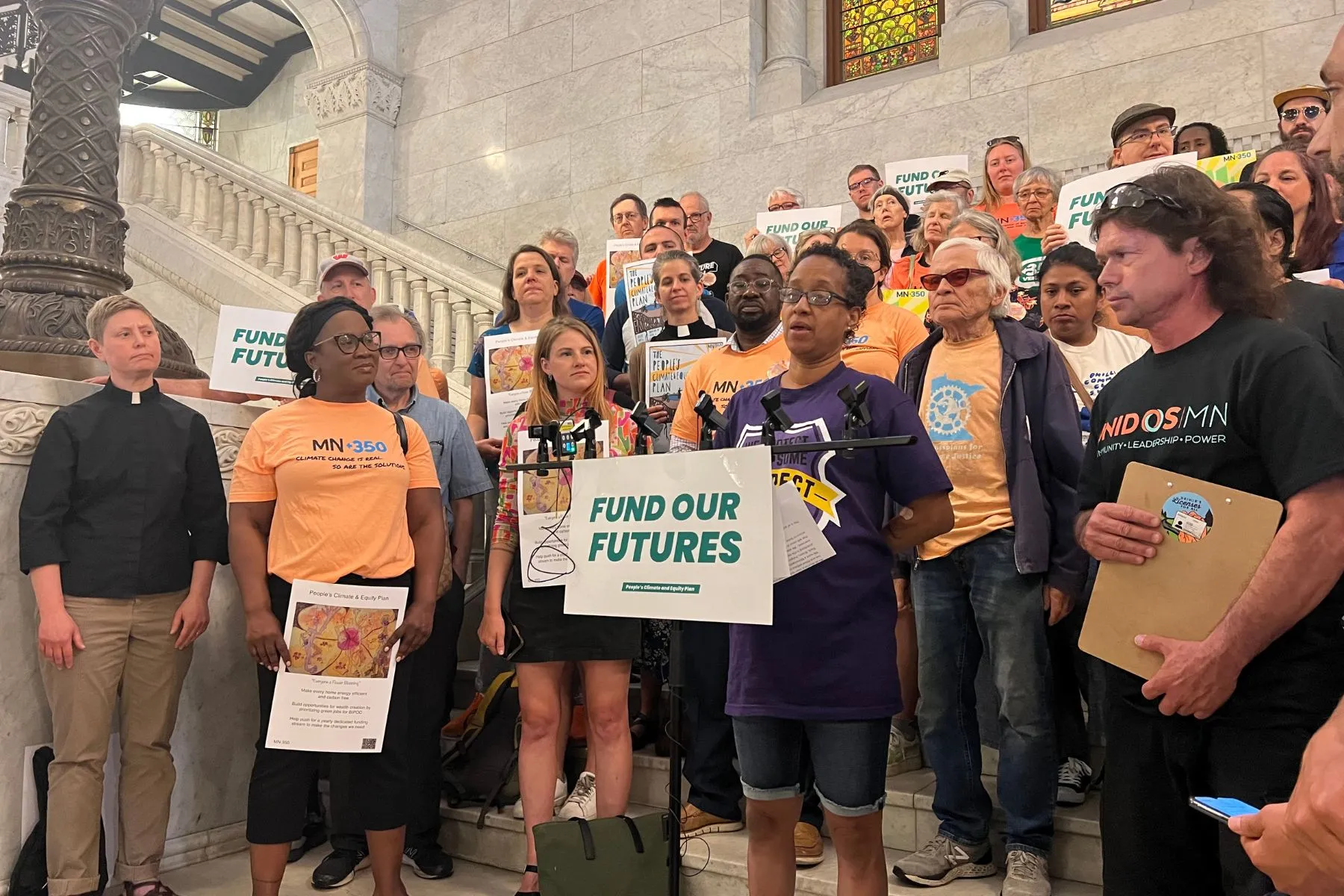
Unidos MN, speaking at their “Fund Our Futures” climate rally in 2023.
Balance Sheets + History Books
Talking with my parents reminded me how sensitive these conversations can be. Affluent Americans today are the largest, wealthiest group of people who have ever walked the face of the Earth. And part of the nature of having wealth is that it becomes normalized. It distorts our perceptions. It raises our expectations in a never-ending loop of more more more more more. And yet most of the time, most of the wealth itself can feel strangely abstract. We experience it as cold numbers on a balance sheet.
What if we could turn some of the numbers on our balance sheets into pages in future generations’ history books?
It had never occurred to me before talking this through with my own parents that they could probably give away a million dollars without it making any significant difference in their standard of living.
The good news: My parents are not alone. There are millions of people like them who could do exactly the same thing: Make donations of six figures or more without significantly compromising their own standard of living.
Millions of Modest Millionaires
Consider this: In America, we currently have over twenty-three million “millionaire” households (18% of the population). About five million households have $5 million or more (3.6% of the population). That’s right – about one in thirty Americans lives in a household with $5 million or more in assets.
Data: Federal Reserve, 2022 Survey of Consumer Finances (SCF). Analyzed by DQYDJ.
Over two million households – one in seventy – are decamillionaires with $10 million or more. And roughly sixty-four thousand are centimillionaires with $100 million or more. The number of millionaires in the U.S. has tripled in the past two decades. The growth in household wealth in just the past few years alone is staggering.
In short, there are a lot of people like my parents who can easily afford to donate a lot more money than they are giving.
There are so many newly-wealthy people in this country. Who are they? They are mostly older – though not all. They are mostly white – though not all. Most of them are not used to the concept of seeing themselves as wealthy. They don’t feel wealthy and, like my parents, they are resistant to the idea that they are; it violates their sense of identity. My mom grew up in the Depression saving every paper clip. Basically, their lifelong mental image of themselves as middle-class regular people has not kept pace with the rising net wealth printed on their balance sheets.
A huge percentage of them are our people: They vote for Democrats. They have liberal values. They are viscerally disgusted by Donald Trump. They read the news and think about politics on at least a semi-regular basis. They want to do something. They just don’t see themselves as protagonists in the movie. At least not yet.
Credit: 1Hood Power in Pennsylvania
From Spectator to Protagonist
It may be that this subtle but significant shift in perception – from disempowered spectator to powerhouse protagonist – is the most important thing we need to figure out how to catalyze in ourselves and others in our spheres of influence. How do we do that?
Perhaps it’s helpful to remember the fictional story from which we borrow the “Bat Signal.” In the movies, Batman is the alter ego of a reclusive, wealthy liberal philanthropist named Bruce Wayne, who responds to calls for help from the public when evildoers attack his beloved Gotham City.
So the metaphor is especially apt: we are sending up a Bat Signal to all benevolent left-of-center people with wealth to heed the call and do heroic things to save our country in the face of diabolical foes and a grave national emergency.
Ideally, we need to very quickly organize a critical mass of people who are willing to go from spectator to protagonist and make their biggest donation ever – be it $10,000, $100,000, $1 million, or $10 million.
I think we can figure this out.
Turn Bucks Blue (Pennsylvania) • October 2022 “Dine for Democracy” grassroots fundraiser
You Are Probably Surrounded By Wealthy People
Remember those stats above about how many wealthy people there are?
Well, if you live in a relatively liberal, affluent community in or near a major metropolitan area or college town, and you associate with other liberal, college-educated people, the percentages of wealthy people in your circles are dramatically higher.
Chances are good that you are surrounded by relatively wealthy people, who in many cases are much wealthier than you realize. They may think of themselves as middle- to upper-middle-class. But like my parents, under the right circumstances, they have the capacity to make a very large donation to something they understand as deeply connected to their immediate self-interest: the wellbeing of themselves and their beloved children and grandchildren.
It’s not that we don’t have the money (we do). It’s not that we don’t understand the problem (we do). It’s not that we don’t have the desire to do what’s right (we do). We just haven’t connected all of the dots together yet to see clearly that:
- We actually do have enough money to make a major investment.
- By making the biggest philanthropic and political investment of our lives, we can make a major difference in the course of world history.
- We should think of changing the world in the same mental bucket that we use to pay for our kids’ college education, or to buy a second home, or life insurance – as an investment in our own happiness and well-being and in the well-being of our family, our community, and the people we love and would do anything for.
That is why the act of creating a giving plan is such a transformational exercise. It allows us to ask ourselves (and our spouses, financial advisors, or other relevant stakeholders) the question: How much money do I truly need to save and invest? How much money do I want to pass along to my children or others? How much money can I donate to make the world a better place? And how much of my giving is actually in others’ best interest to do now vs. later vs. after I’m gone?
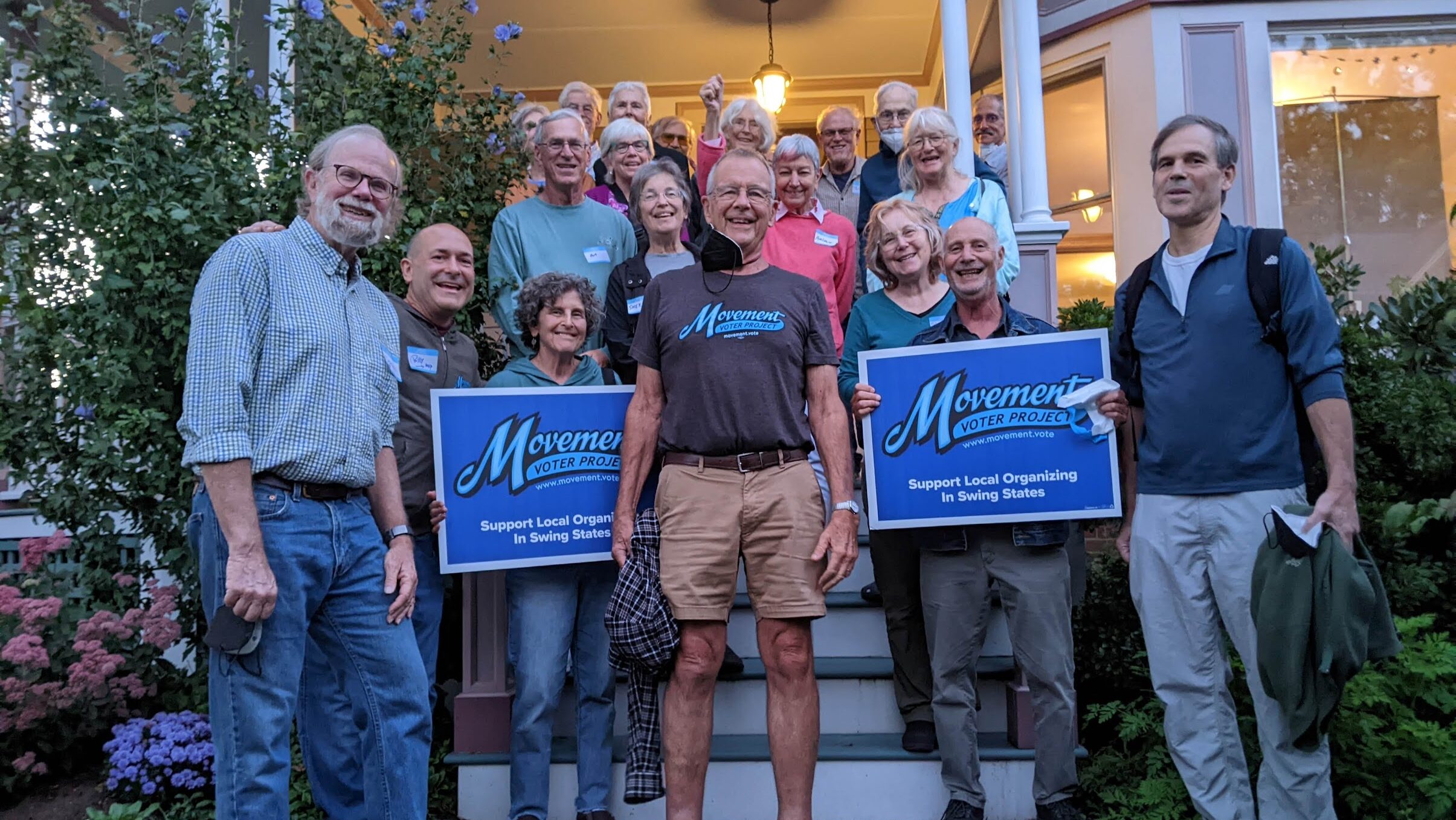
The MVP Western Massachusetts Volunteer Team, launching their 2024 donor organizing campaign
Six Degrees of Separation: A Teacher in the Midwest
I think there’s something in the water right now.
I was at the gym last week, and virtually unprompted, the guy next to me on the elliptical machine told me his family is preparing to move to Canada if Trump wins. “I think there’s a 75% chance he gets elected. This is straight out of Germany in the 1930s. People forget that Hitler was elected. The left was divided. He became a dictator over time. I know how this story ends – it doesn’t end well.”
When I told him about MVP, he seemed to feel a twinge of hope and even offered to do a benefit concert for us with his Rage Against the Machine cover band (!). Another parent on my kid’s soccer team told me she wanted to volunteer. It feels like folks might be starting to pay attention in a new way – beyond the usual suspects.
Then recently, one of our donors really blew my mind.
Back in 2022, a local MVP volunteer team in Massachusetts organized a house party and sent invitations to their friends. A couple of their friends were expats living in Europe who got very excited and sent a very compelling email to their friends in New York. One of those friends sent it to another friend who sent it to his family. And that person’s mom, a retired elementary school teacher in the Midwest, was inspired to make a $1,000 donation. The Midwestern retired teacher – who was literally six degrees removed from MVP – then got added to our mailing list and started reading our monthly newsletters.
A few weeks ago, out of the blue, she wrote me a note after reading our “Bat Signal” memo and watching Trump’s scary polls and statements. She said she’d like to talk about making a larger contribution. We got on Zoom. She said in a very even-keeled way: “This is an existential situation. We believe in your work. And we want to give you a million dollars.”
There is so much hidden wealth in America – so many people you would never guess who have the potential to give major donations. We are all connected to way more people than we know. The volunteers in Massachusetts, and the first five people in the forwarded email chain, had no idea their simple act of forwarding an email to friends would lead to a million dollars.
Every single one of us is more connected and influential than we can imagine.
Credit: The Alaska Center
The “Delay Gap”
Many affluent people have the genuine intention to give away large sums of money and be very generous at an undefined date in the future. I recently learned that there is a term for this phenomenon among high-end philanthropy professionals: the “delay gap.”
Having talked it through with my parents, I understand in a much more personal way now why Donor Advised Funds (DAFs) are so popular: they’re a way to avoid capital gains on appreciated stocks without having to make a decision right away about what to do with the money (which is why $234 billion is just sitting around in DAFs while the world burns. Shout out to #HalfMyDAF for working to address this).
Of the 240 Giving Pledge signatories who have all publicly pledged to give away at least half of their wealth in their lifetimes, almost every one has grown significantly wealthier since they made the pledge.
What are they waiting for? Apparently, for a very special unspecified date in the future on which to make good on their promise.
But ask yourself: With climate chaos upon us and MAGA breathing down our necks, what day in the future is likely to be more strategic, better-timed, or more consequential than the next few months – which are the last few months when we can still give money early enough to make an outsized impact on the 2024 election?
Are we waiting for after we have an authoritarian regime to finally find our inspiration? Are we waiting for climate tipping points to pass, so we can donate to the relief efforts? Are we waiting until after we die to leave it in our wills, and surprise everyone with our posthumous grace?
What if, by that point, it is simply too late?
Credit: Minnesota 350 Action
Nothing Compares
Here is the reality: There is nothing we can give our money to that will make a greater difference than blocking authoritarianism and electing a Democratic governing majority in 2024. Nothing.
We may be motivated by concerns about climate change, reproductive rights, voting rights, racial justice, education, the arts, hunger, human rights, and any number of issues. But there is nothing we can do with our money that will have a bigger impact on any of these issues than deciding who will win control of the U.S. government — the single richest, most powerful entity in the history of the world.
And we – humble little us – have the opportunity to steer it in the right direction. We have the opportunity to turn the Titanic before it hits the iceberg. We have the opportunity to use our country’s massive power and wealth in a better way.
There is nothing that any of us can give money to that remotely compares to the impact, the strategy, the ROI, and the wisdom of steering that ship in the right direction at this tipping point moment in history.
Nothing else compares.
There is no more effective way to be altruistic. The massive scale and awesome opportunity for doing good that comes with political power is in a category by itself.
The marginal impact of donations here can hardly be overstated. With democracy itself on the line and climate tipping points looming, there will never be a more effective time to decisively shift the course of human history than the next few months. If you are an effective altruist – or anyone trying to maximize the impact of your giving in a thoughtful, rigorous way – please join us. We need your help.
Today is that rainy day. That double-rainbow sign from God. That moment of truth at that unspecified time in the future we have all been waiting for.
We have arrived at the moment of truth.
First Knock Out the Bad Guys. Then Defuse the Bomb.
Not long ago, I was talking with a friend who is an MVP donor in her eighties, and I was thanking her for making an especially large gift. I asked her what inspired her to give bigger than usual and without missing a beat she retorted dryly: “there’s no luggage rack on a hearse.”
One of the great benefits of giving in the present – and giving while living – is that you get to witness the impact of your gift. It is a gift to yourself as well as others, to get to enjoy the fruits of your investment in democracy while you are still alive to appreciate it.
Maybe in some bygone era it made sense to conserve the money over time. Right now is not that time. We are in a race against the clock with climate chaos. And we are in a struggle for power with a massive authoritarian right-wing political cult.
We are like the superhero who is trying to deactivate the bomb (before it blows up the planet) while fighting the bad guys, while injured and heartbroken, all at the same time. At this moment, we are all called on to be that superhero. First, we have to knock out the bad guys. Then we have to defuse the bomb. The sequence is important. Because if we don’t knock out the bad guys first, the bomb will explode and nothing else we do matters.
That’s how it works with climate chaos and authoritarianism. The more climate chaos we sow, the more it will trigger climate migration and scarcity, which leads to more fear-based politics, which leads to authoritarianism, extremism, polarization, and political violence. Close the borders! Less for them! More for us! Kill them! Protect us! These are the conditions that distort democracies and elect dictators — it’s happening all over the world.
In America, we have this one itsy-bitsy little window to get ahead of this dynamic – and to try to stop it globally. We have, admittedly, a narrow path. But we do have a path.
We’ve defied the odds and beat MAGA before – in 2018, 2020, 2022, and 2023. There is no reason why we can’t do it again in 2024.
ACT II: The Strategy to Win
From Match Point (2005) film. “There are moments in a match when the ball hits the top of the net, and for a split second it can either go forward or fall back.”
Match Point for Democracy
Let’s take a closer look at the current political state of play.
Right now, winning the Presidency in 2024 is at best a 50-50 proposition. Liberals like to smoke our own MSNBC distraction crack – from the Trump trials to the Colorado Supreme Court ruling, but none of these twists and turns are likely to alter the fundamentals of the race. Even if Trump were somehow miraculously derailed from the Republican primary, our chances wouldn’t be any better against Ron DeSantis or Nikki Haley, and their administrations would be almost as bad given that the Republican Party is now a wholly-owned subsidiary of the MAGA political cult.
If we the donors and Democratic activists continue to operate in our current demoralized, wait-and-see, low-energy mindset, we will shift the odds in MAGA’s favor to something like a 60-40 or 70-30 advantage in winning the Presidency. And the Senate is at least as challenging, arguably more so.
To use a tennis metaphor, 2024 is a “match point” that is likely to be decided by a few thousand votes in a handful of states. Depending on which way the ball breaks over the net – which side works harder for victory, and which side wants it more – the entire course of history could genuinely swing either way.
So what are we going to do?
In his classic longitudinal study of the most successful companies of the twentieth century, Good to Great, Jim Collins found that the highest-performing organizations are able to “confront the brutal facts” yet simultaneously “maintain unwavering faith.”
Those seem like good instructions for us at this moment in history.
Biden’s Bad Polling
For anyone paying attention to polling a year before Election Day, the past few months have been a rollercoaster (or a “pollercoaster,” as the folks at Pod Save America aptly put it).
For those catching up, the short version is: The polls are not good for Biden.
Here is MVP’s analysis:
We need to take these polls seriously, but not fatalistically.
Fundamentally, polls cannot predict close races — especially not this far out.
Why? Because voters do not answer a survey the way they fill out a ballot. Polls capture a snapshot of voters’ feelings and frustrations, which may or may not reflect how they decide to vote.
And, even if polls could accurately predict people’s voting intent, that intent could and likely will shift between now and the start of voting.
Progressive political guru Michael Podhorzer puts it clearly:
“Pollsters want voters to tell them who they will vote for next November; voters want to tell pollsters how unsatisfied they are now with the direction of the country and their own lives. For most of this century, Americans have said the country was on the wrong track – and they have taken out those broader frustrations on whoever was president at the time. Low presidential approval ratings are now the norm in the United States (for old and young presidents alike), in a stark contrast to the last century.
“To be clear, I’m not saying that Biden is going to win – just that there’s no reason to declare him likely to lose. But media outlets create this narrative out of thin air when they choose to field and devote so many headlines to horserace polls a year out from the election. This saps our agency as voters by creating a false sense of inevitability about the final outcome.”
It’s not “game over,” it’s “naptime over.”
Simply put: Polls this far out are not predictive of outcomes. They are prescriptive of what we need to do. The only good use of a bad poll is to wake up, not to give up.
Infographic credit: NBC News
Turnout Will Determine How It Turns Out.
In 2016, Trump won by 77,744 votes in three key states — just 0.06% of all votes cast.
In 2020, Biden won by 42,844 votes, in a slightly different triad of states — just 0.027% of all votes cast.
2024 is likely to be just as close.
These miniscule margins are mind-boggling, and until pollsters gain psychic powers or the ability to time-travel, they are well within the margin of error of any poll.
This means it will all come down to turnout, which is one thing we can influence.
Black Voters Matter Fund, getting out the vote in Kentucky, in front of their iconic “We Won’t Black Down” bus.
The One Thing in Our Control
There is a lot about the national political environment that is largely outside of our control. The economy and how it is perceived. Third-party candidates. The trajectory of devastation in Gaza and the politics of the U.S. role in Israel and Palestine. And other unforeseen domestic and world events. We could easily have more wars, climate disasters, economic shocks, scandals, candidate plot twists, and God-knows-what-else between now and next November.
Even with all of these factors, known and unknown, the most likely scenario is that a few thousand votes in a handful of states will tip the Electoral College and control of Congress, and with them, the future of the country.
Which means that there is one major factor that is very much within our control: The level at which we choose to resource the local voter mobilization groups who are best positioned to get voters into the polling booth – or sending in their mail-in ballots – and getting us the heck out of this mess.
Trump is not inevitable. He is a walking dumpster fire. As a candidate, he has strengths and weaknesses. Biden is not inevitable either. He has strengths and weaknesses. At the end of the day, the election is in our hands. We just have to actually put in the work to close the deal.
Sometimes, it feels like we have been gawking at the 2024 election like it’s a car crash on the other side of a six-lane highway. We haven’t quite processed that the car crash is happening just ahead of us on our side of the highway. We need to swerve off the highway to avoid crashing. When you are facing an unprecedented life-or-death situation, it is time to do unprecedented things. We have to act quickly. We have to climb into the driver’s seat, grab the steering wheel, make the biggest investment we have ever made, and change direction to save ourselves and our precious cargo.
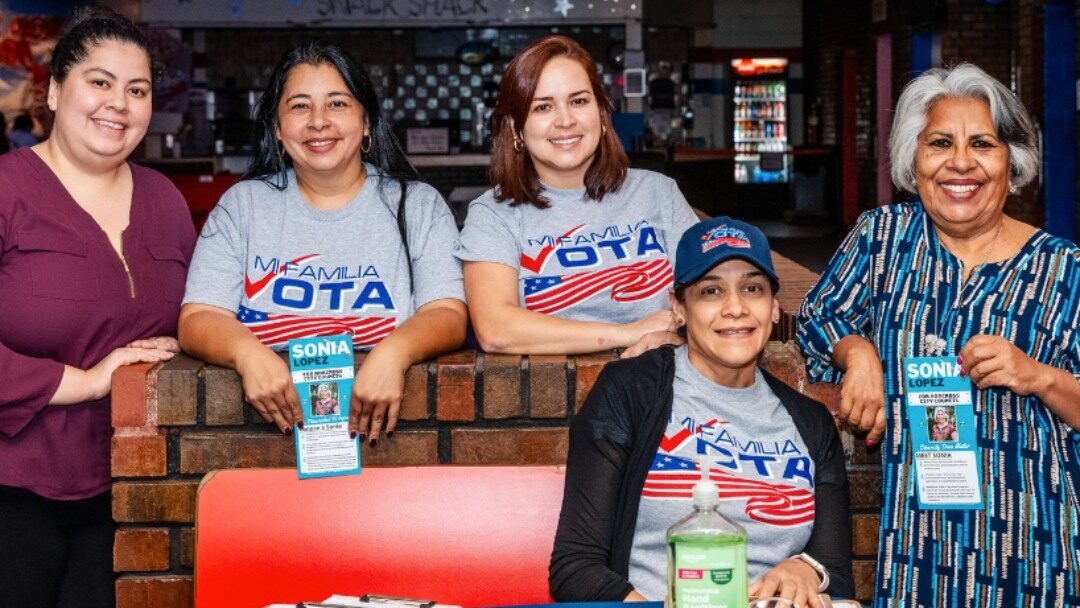
Credit: Asian Americans Advancing Justice in Atlanta (Georgia)
The Gap Is the Ground Game.
For an election in which turnout will be the most important factor, the Biden campaign is operating in a curiously low-key fashion.
For comparison, in the fall of 2011, the Obama re-election campaign had more than 300 staff already hired going into 2012. Eventually they had 800 local campaign offices. Guess how many staff the Biden campaign has so far? According to their October 2023 filings: 38. It looks like ads and public appearances are their primary strategy, with a side order of digital micro-influencers. These are all necessary strategies but far from sufficient.
The idea that they will even attempt to run a robust ground game is seeming more and more remote. Essentially, by default, they are depending on the kinds of local grassroots organizations that MVP and our allies support, to run most of the ground game for them. But they’re not saying that explicitly. They’re not saying: “Hey donors! We’re not running a major ground game this time. Please make sure you fund the outside groups to do it for us.”
Given campaign finance laws, it probably isn’t even legal for them to say that. But it’s important that somebody does.
Here Is The Plan.
Given the Biden campaign’s lack of robust field operations, MVP is taking our work of funding locally-based organizing all the more seriously. Our team of regional and state strategists and advisors have been putting together plans to supercharge voter organizing in all the key states — now all that’s needed are the resources to fund it adequately.
The Battlegrounds: Where We Need to Win
Where: We need to focus most of our resources on the nine critical Presidential and Senate battlegrounds (AZ, NV, GA, NC, WI, MI, PA, OH, MT), and secondarily on the approximately forty most competitive House districts. The more funds we can mobilize, the more money we can also move to secondary battlegrounds with key down-ballot and long-term contests (especially control of state legislatures) that would be unwise to completely forget about. More on targeting here.
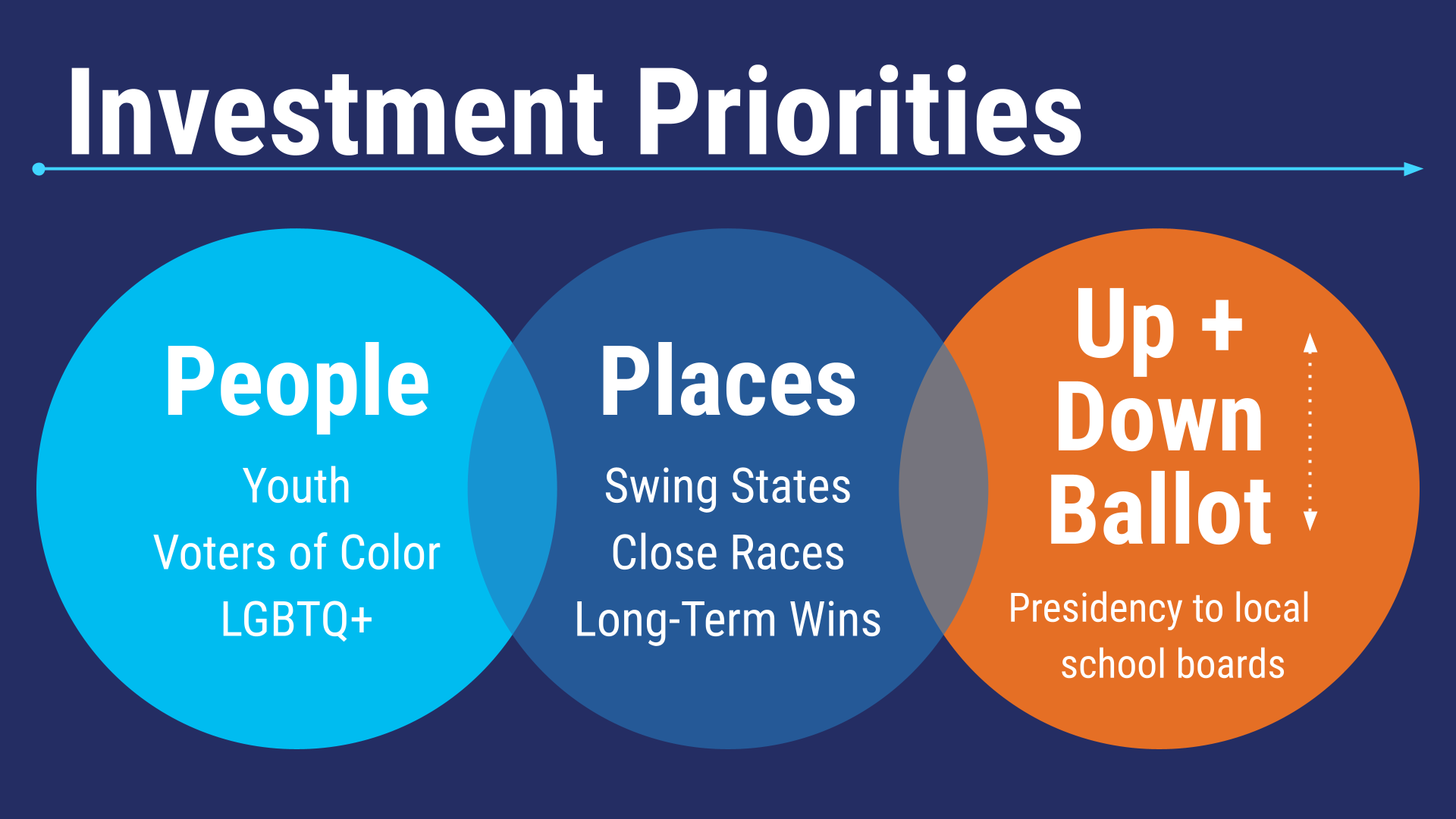
Who and how we target voters: No surprise: we need to focus on young voters, voters of color, women, and other often-marginalized communities such as immigrant and LGBTQ voters.
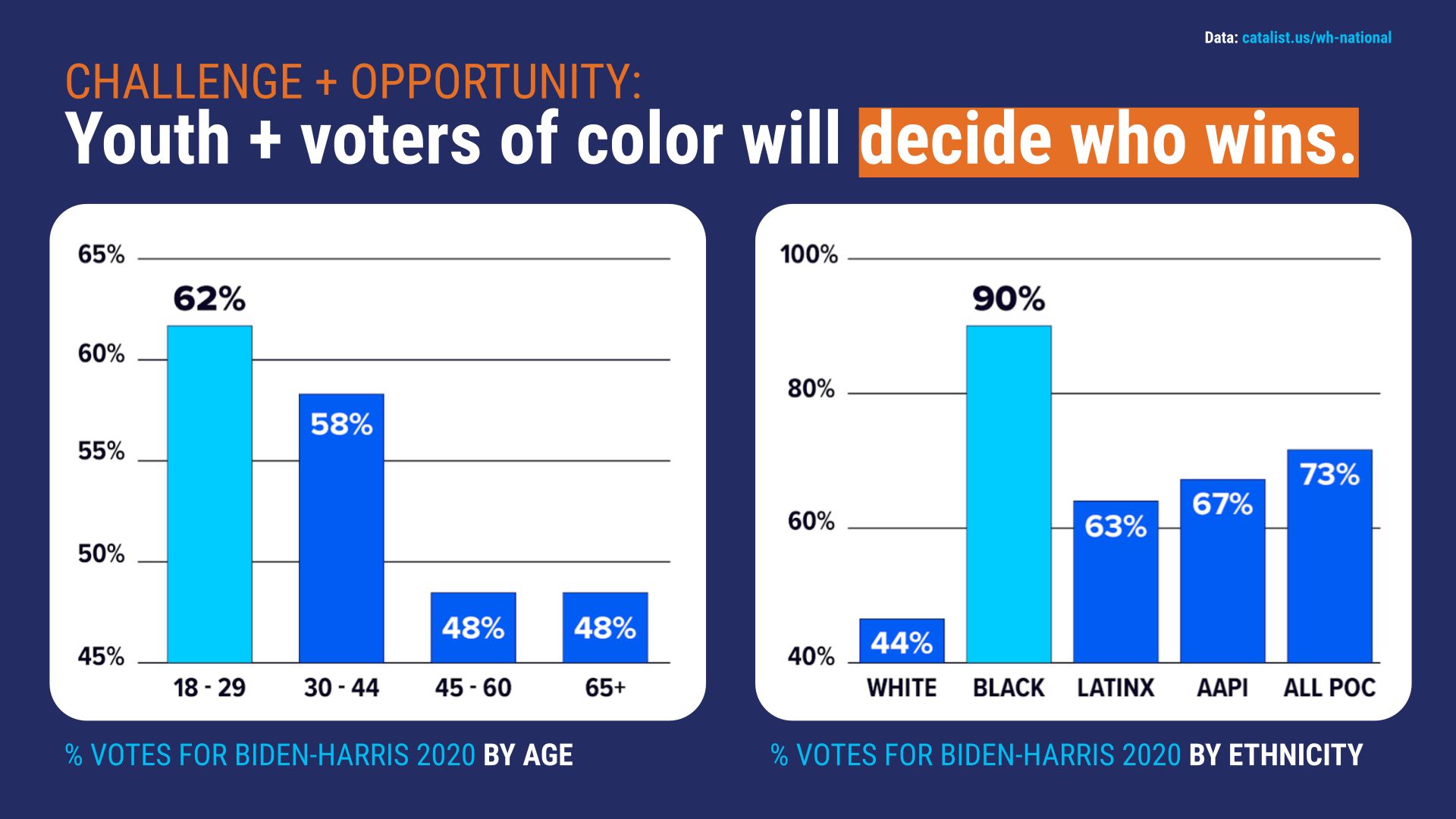
Source: catalist.us/wh-national
We also need to reach out to cross-pressured white voters, male voters, union households, rural voters, working-class voters, and persuadable independents of all races. We can’t afford to take any community of voters for granted in 2024.
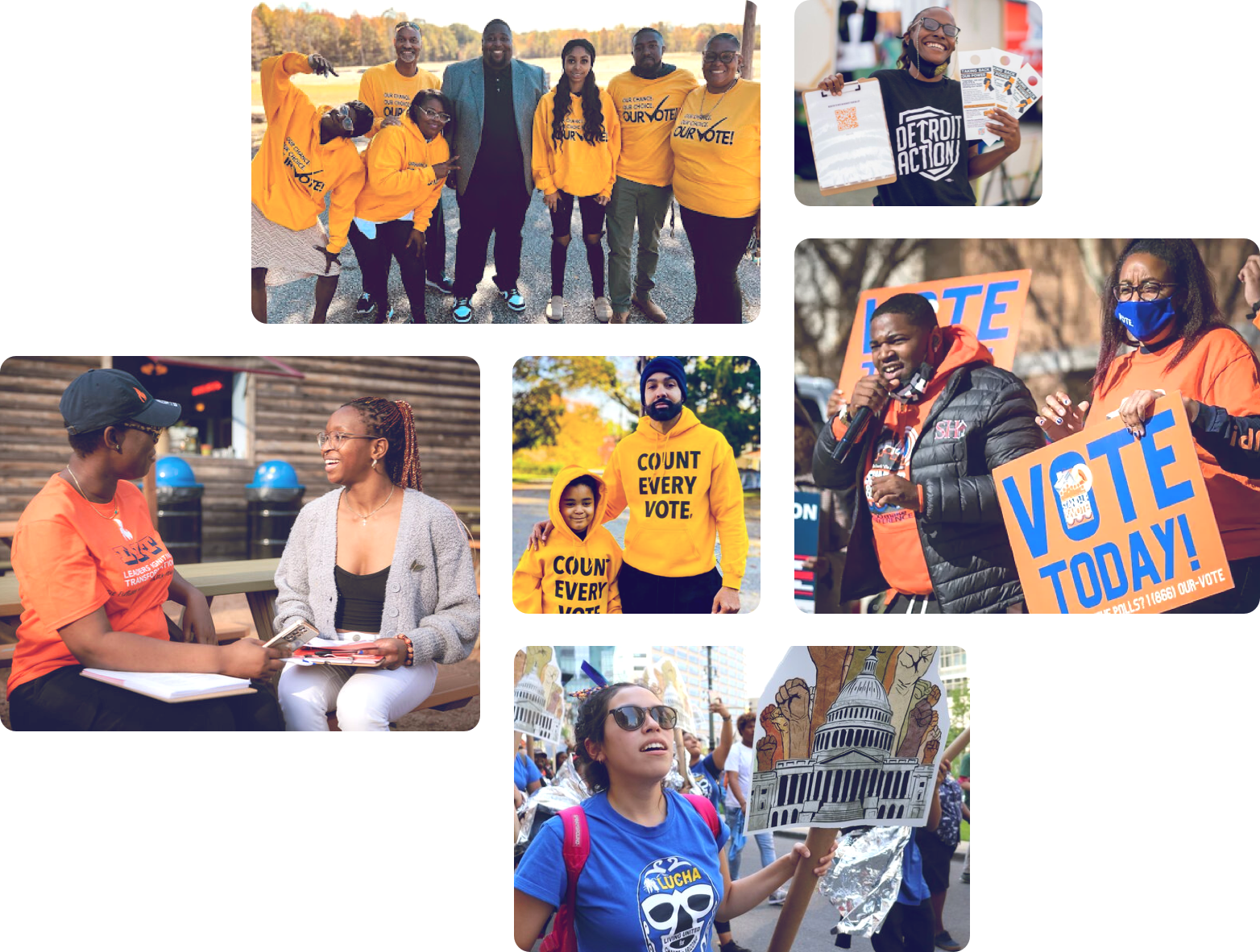
MVP local partners, clockwise from top left: Advance NC, Detroit Action, GA Alliance, LUCHA (AZ), Leaders Igniting Transformation (WI), 1Hood Power (PA)
Frontline Organizers: Our Best Hope
Especially because enthusiasm, trust, and awareness of Biden’s accomplishments is low, our best bet is to fully fund the maximum plans of the hundreds of local and multi-state organizations that have track records of registering, educating, galvanizing, and turning out these voters.
These organizations fall into roughly five categories in terms of scope and scale:
- Major multi-state anchor organizations (there are approximately 100 of these), like People’s Action and the Alliance for Youth Action.
- Small-to-midsize national players (approx. 200), like UnPac and Be a Hero.
- Major state-level groups (approximately 100 in the battleground states), such as Living United for Change in Arizona (LUCHA) and New Georgia Project Action Fund.
- Mid-sized local groups (approx. 100), such as Durham for All (in North Carolina) and 1Hood Power (in Pennsylvania).
- Micro-local groups (approx. 1,000) such as the many small town organizations in Georgia’s rural Black Belt supported by Black Voters Matter Fund.
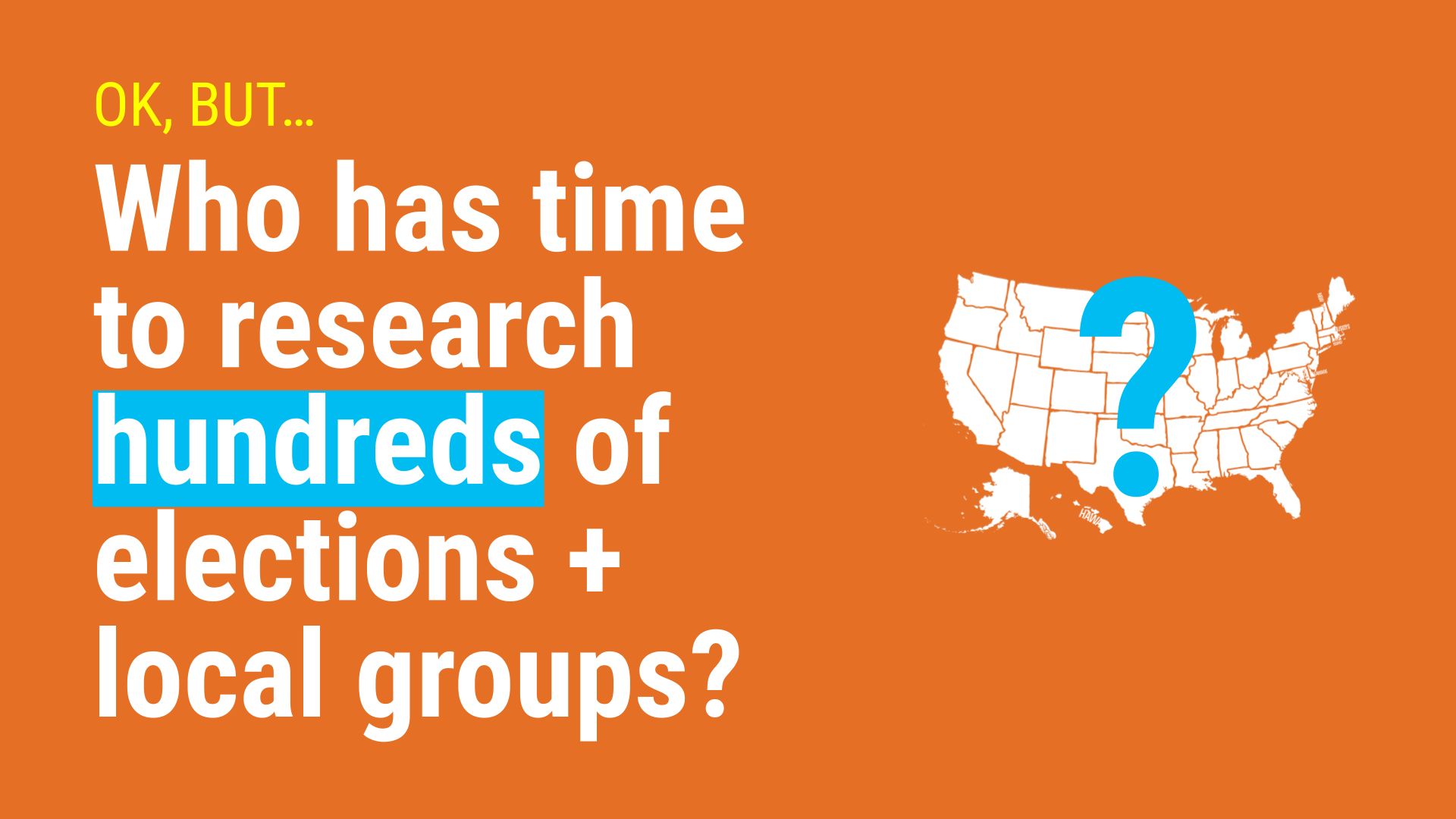
When we look at these numbers of groups, it does beg the question: Who has the time (and expertise) to analyze political trends, find the key races, research the best groups, and constantly recalibrate their funding for maximum political impact?
Almost nobody.
This is where I believe MVP and our allied funding intermediaries play a critical role in dramatically streamlining the money-moving process.
Overall, MVP is probably the single largest “supply line” to most of the top 200 large and mid-sized local voter engagement groups in the top battleground states. We probably represent 10-20% of the overall funding for the progressive voter engagement field as a whole within the categories of groups we support.
We know these organizations are effective because they use proven voter contact methods, based on 25 years of research and hundreds of randomized control trial experiments. Collectively they have the experience, the relationships, and the scale to break through the white noise and actually move the dial. They are our best hope.
Trusted Messengers Do It Better.
Local frontline organizers are the trusted messengers who are going to do the actual work to listen and talk with tens of millions of voters; to register, educate, organize, protect, and persuade them; and to generate enthusiasm next fall.
We know these groups are effective because they use relational approaches to voter contact that have been empirically shown — and road-tested in recent election cycles — to produce a greater effect on turnout.
They have done it before. They can do it again. They just need adequate support to do their (increasingly challenging and dangerous) jobs.
Because of the unique dynamics of the 2024 race, targeting and persuasion are going to be a much bigger part of our local partners’ plans, even with young voters, Black voters, and other constituencies that Democrats typically engage around registration and get-out-the-vote.
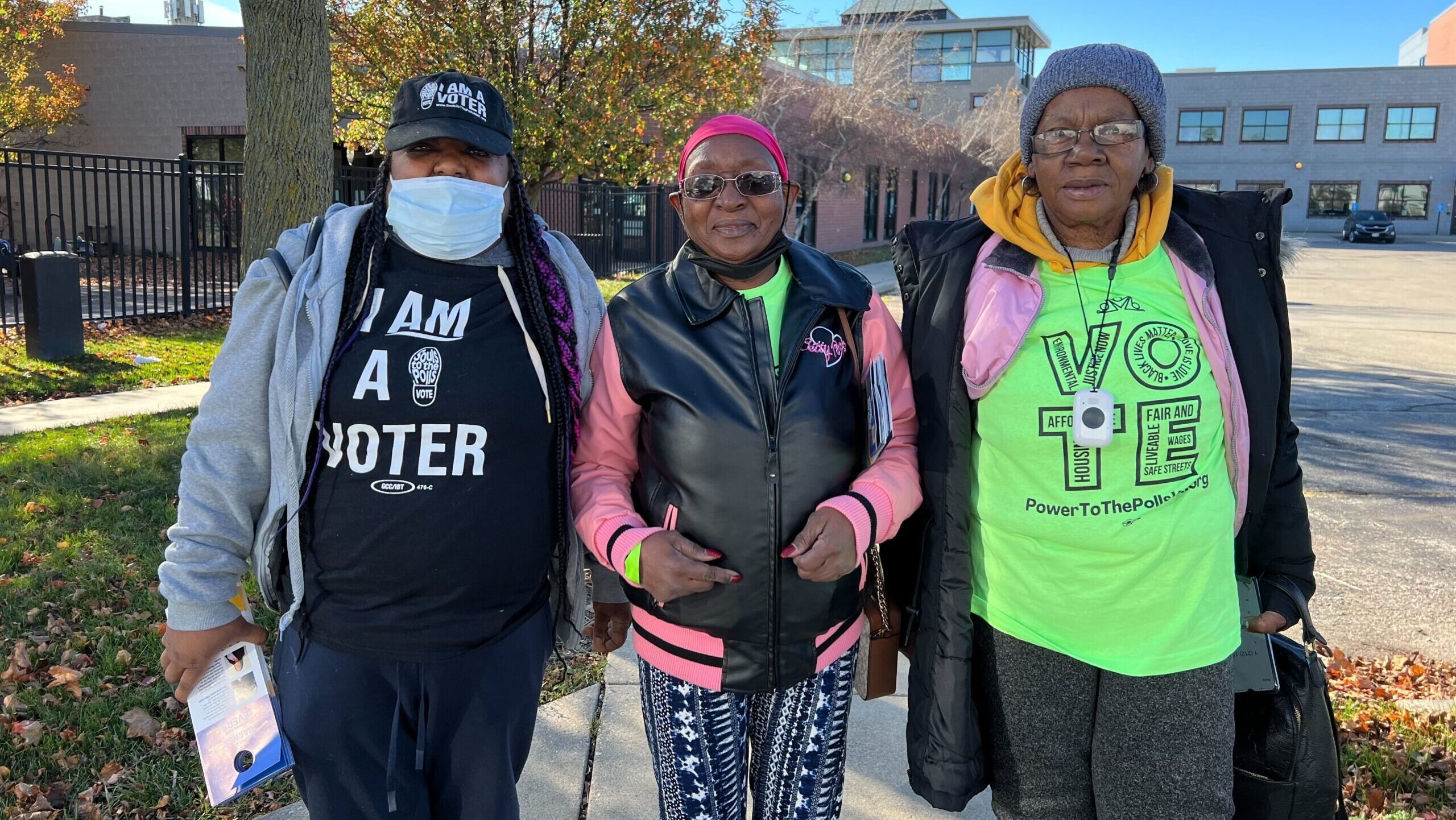
Power to the Polls getting out the vote in Wisconsin, 2022
Our partners have to train their organizers with deep canvassing skills, empathetic listening, personal storytelling, and tested messaging to inoculate against and counteract the many divisive wedge issues that the other side is throwing at us.
From racial dog whistles to anti-trans, anti-immigrant, anti-Muslim, and anti-Jewish scapegoating, to economic misinformation and red-baiting, we have to prepare our canvassers to be ready for anything and everything in the right-wing kitchen sink of boogeymen (“George Soros and the tree-hugging socialists are bringing Black Muslim immigrants across the border to raise the price of gas and turn your child trans”).
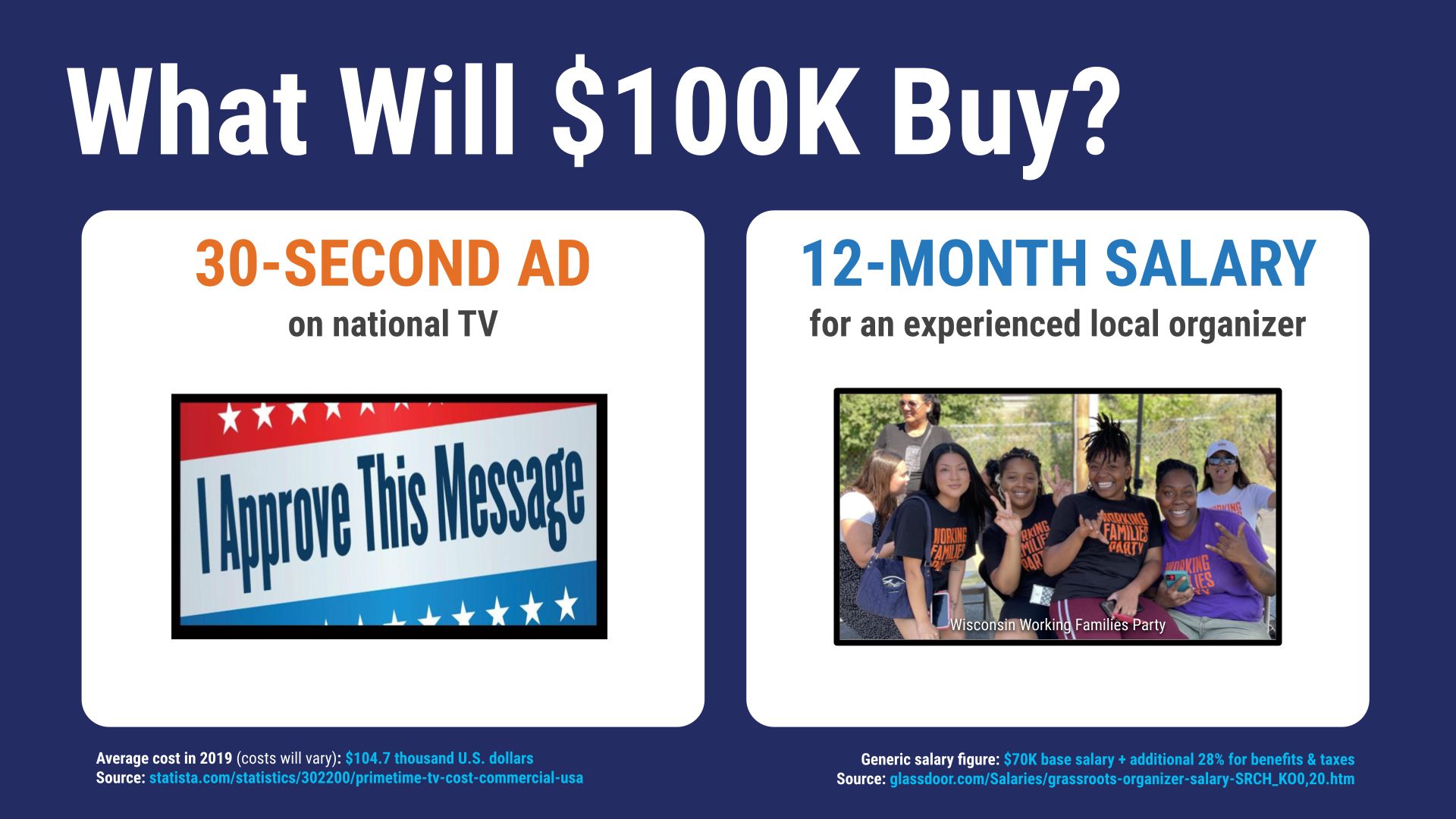
Sources: Statista + Glassdoor
This is where it’s especially helpful to have on-the-ground organizers who aren’t just serving digital ads to voters using out-of-date, incomplete voter file data. Local organizers are trusted messengers who can have real in-depth conversations in a human-to-human way, which research has shown to be highly effective in shifting views on divisive topics.
In terms of micro-targeting within racial or geographic communities, local organizers tend to be more rooted in the more progressive parts of youth communities and communities of color – so there is some helpful self-selection in who they target within their communities. Local organizers have a deeply intimate and nuanced knowledge of which segments of youth and BIPOC populations to prioritize or deprioritize for persuasion vs. turnout that national campaigns and algorithms can simply never match.
This is one of the superpowers of local and relational organizing – the intimate specificity of the knowledge organizers have about their communities – down to the micro-micro level (e.g. “Jamie’s uncle is going to need some deep canvassing on trans issues,” or “Don’t GOTV that fraternity house but do GOTV that one.”).
And even if Democratic performance goes down some (e.g. if Black communities’ Democratic turnout goes from 92% to 85%), and even if our partners weren’t engaging in targeting, persuasion, and operating with some built-in self-selection bias, it’s still a huge net gain to double down on well-targeted investments in voter engagement. This is especially true in Black communities, whose turnout represented more than the margin of victory in each of the six closest states Biden won in 2020: Georgia, Arizona, Wisconsin, Pennsylvania, Michigan, and Nevada.
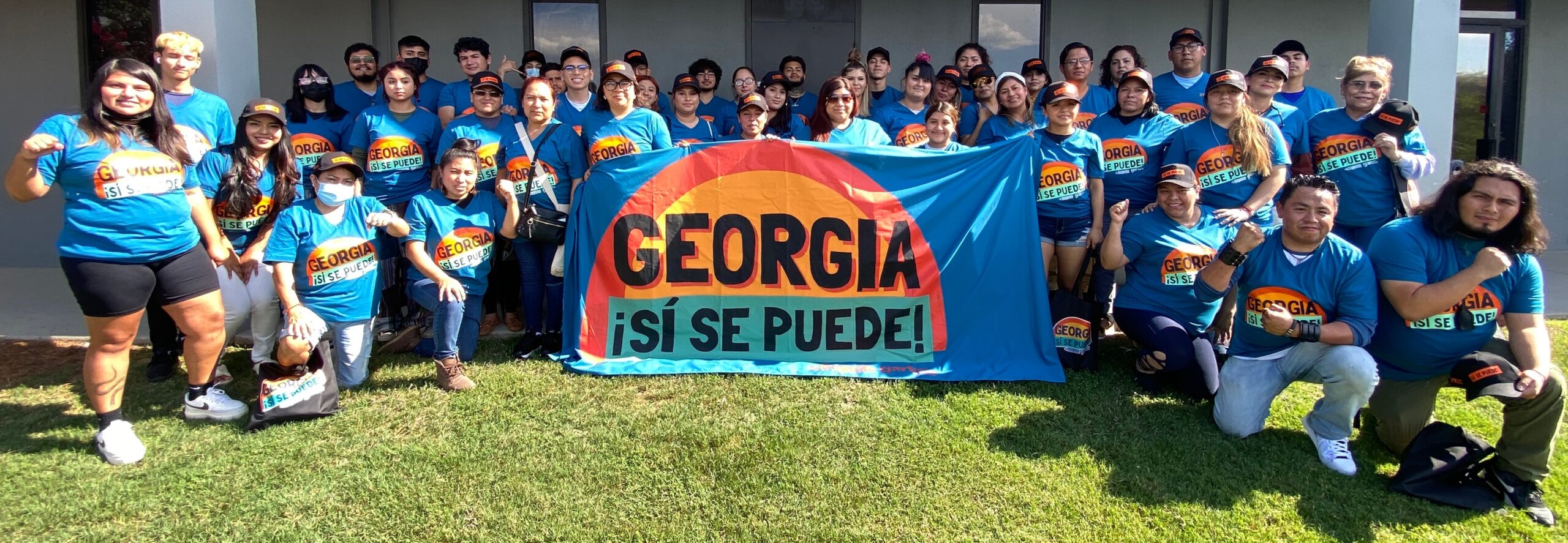
Credit: Georgia Latino Alliance for Human Rights (GLAHR) Action Network
That’s it. That’s the solution.
Target the battlegrounds. Fund the organizers. Do it now, not months from now. It’s not complicated.
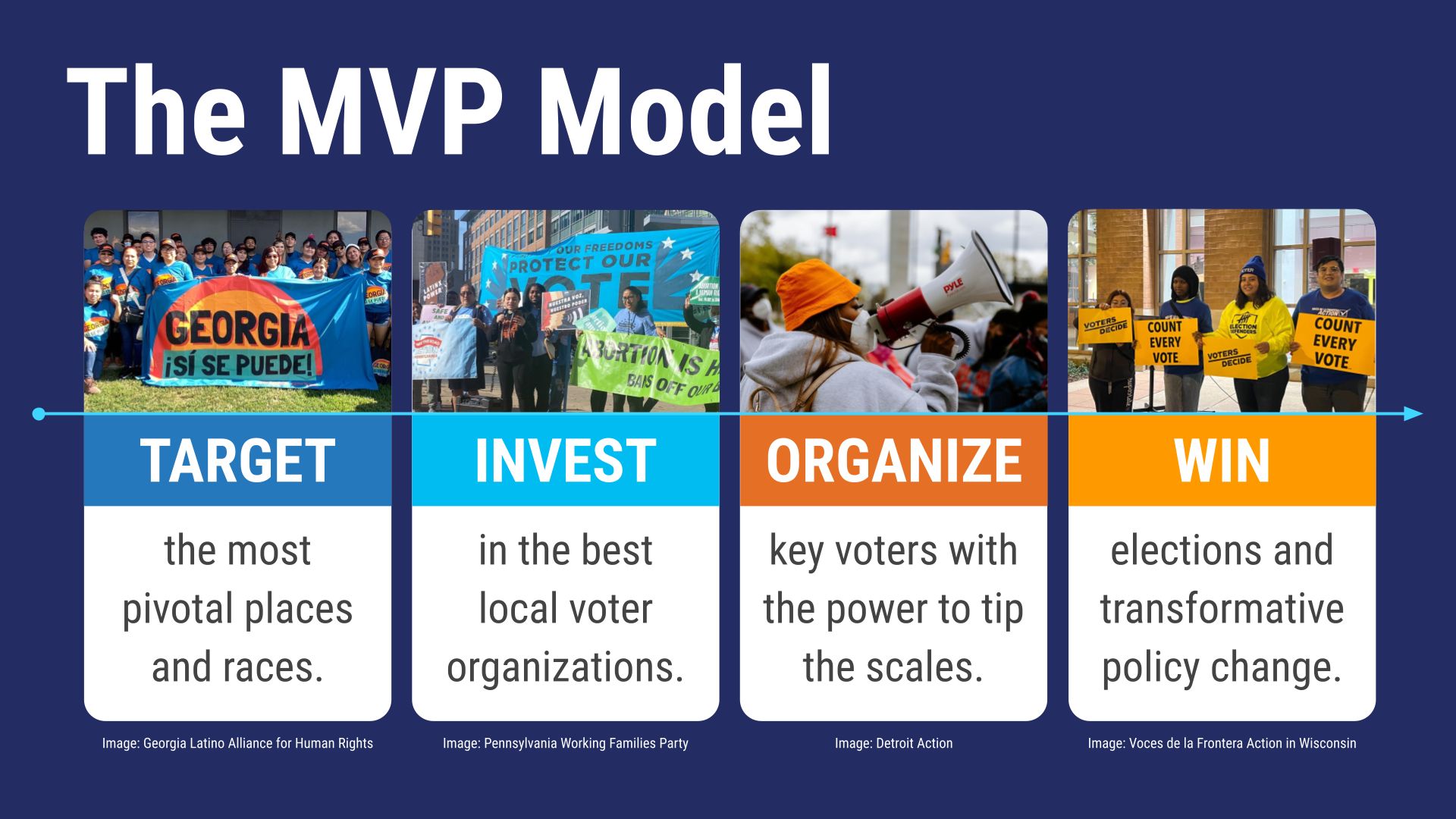
The organizers are the frontlines. The donors are the supply lines. If we, as donors, follow through on doing our job — getting the funding to the frontlines as quickly as possible — so that organizers have the resources they need to do their jobs at the highest levels of scale and excellence.
Conversely: If our ground game is not extremely well-funded in the next few months, we will be going into the election with one hand tied behind our backs.
How Much Money Will It Take?
In the 2020 election, our side collectively donated and spent over $1 billion on hundreds of progressive voter engagement organizations and efforts (outside of the Democratic Party), which generated unprecedented turnout and carried Biden over the finish line – by the skin of his teeth. This figure does not include the more than $1 billion spent on nonpartisan voter engagement and election administration efforts.
In 2024, we will collectively need to invest at least $2 billion – ideally $3 billion – due to inflation, wage growth, and stronger political headwinds, to try to match our performance in 2020. We have to assume the other side is going to have unprecedented turnout. So we need to have unprecedented turnout on our side too.
MVP has a baseline goal to move at least $100 million to the field this election cycle, mostly to the top nine swing states above, but also in smaller amounts to secure statewide power in states like Minnesota and Alaska, and win House races from New York to New Mexico. $100 million is a modest goal compared to the need: The field could constructively deploy ten times as much.
Ideally, to reach these goals (and even bigger goals in partnership with our many allies), we need a handful of mega-donors to step up and pledge somewhere in the $5-10 million range. We need to find a few hundred major donors to pledge in the $1 million range; a thousand major donors in the $100,000 range, and so on via peer-to-peer challenges.
If you are someone for whom these dollar amounts are simply light-years higher than your personal capacity to give: We need you, too! The more broad-based our movement of donors, the more successful and sustainable all of our long-term efforts will be.
And, remember the story about the retired teacher from the Midwest: When our Western Mass volunteers put out the invitation for their house party in 2022, they would have been happy if a few thousand dollars came out of it. There is no way they could have known that, one year later, we could trace a million-dollar donation directly back to their efforts. This story is not an anomaly – it happens all the time.
We Really Can Have Nice Things
The Amazing Scenario
We’ve talked now about what it’s going to cost to give us the best chance at winning. And we’ve talked about what it will cost us if we lose. I want to say a little more now about the incredible, beautiful, hopeful vision of what is possible if we meet this moment.
In the Bat Signal memo, we called this The Amazing Scenario. In short: If we course correct quickly — and make the biggest investments we have ever made — we can:
- Win the Presidency and both chambers of Congress.
- Gain the single additional progressive U.S. Senate vote we need, by replacing Kyrsten Sinema with Ruben Gallego in Arizona.
- Pass some of the most progressive legislation of our lifetimes in 2025.
- Appoint hundreds of judges, and have a chance to replace one of the right-wing Justices on the Supreme Court.
- Harness the tailwinds of demographic change and structural democracy reforms to usher in the beginnings of a twenty-first-century Progressive Era.
2025: The Most Progress In Decades
After having our policy hopes dashed so often, many of us have learned to expect the mediocre. But if we can win a Democratic governing majority with an additional reliably progressive vote in the Senate, we will actually have the votes we need to have an even better legislative session than we had in 2021-2022, and secure some major new historic policy wins.
In 2021-2022, we were just one Senate vote short. With one more vote, we could have passed a bill close to the original Build Back Better Act vs. the $433 billion Inflation Reduction Act, which—while still full of impressive progressive legislation—was watered down to meet the demands of Manchin and Sinema. This means with a federal trifecta in 2025, we easily pass:
- Far more ambitious climate provisions,
- A permanent expanded child tax credit (the temporary version of which cut child poverty in half in 2021),
- Significant healthcare and Medicare expansion,
- Funding for universal pre-K and childcare,
- National paid family leave, and
- A path to citizenship for undocumented immigrants.
And, with the additional reliable Senate vote, we would be in reach of reforming the filibuster in order to secure national abortion rights, pass federal voting rights legislation, curb the influence of dark money, and end partisan gerrymandering, which would be utterly game-changing for the future of state and federal politics in this country.
Specifically, if we can pass fair redistricting, we could have:
- The greatest expansion of democracy and voting rights in decades.
- The beginning of an era of increasingly durable Democratic majorities at the federal level and in a growing number of states.
In 2022, Democrats lost the U.S. House (and their full governing trifecta) by just 6,675 votes across five districts (0.006 percent of all House votes cast). With fair U.S House maps nationwide, Democrats could have gained six additional seats.
At the state level, Democrats now have trifectas (i.e. control of the executive and legislative branches) in 17 states representing a plurality of Americans — including Michigan, where newly-drawn legislative maps led to the first Democratic trifecta in forty years in 2022. Fair maps nationwide could help clear the way for progressive governance in the next decade, in some of the worst gerrymandered states like Georgia, Texas, and North Carolina.
And if we succeed in winning that level of structural reform, the sky’s the limit on what we can do over the next decade to advance every other policy we care about. We can make the 2024 elections a true turning point in American history and chart a course to transform the 2020s and 2030s into a new Progressive Era.
Advance North Carolina, getting out the vote for a “Knock Your Neighborhood” canvass in Mecklenburg County.
Getting Our Swagger Back
I am hoping that the worst of the funding drought is behind us. But the problem is far from fixed. Many groups we know have simply contracted and are operating in survival mode instead of in the more expansive swing-for-the-fences mode that won us the 2020 election – by a hair). The field as a whole has tightened their belts, and they’re going to need a lot more resources to regain the level of aggressive enthusiasm we need going into 2024.
Ideally, we need to give groups enough funding to run their maximum programs in 2024. As donors, we need to help our heroic frontline leaders regain their sense of financial security and confidence. We have to recognize that they have taken a big hit in the last year – and many of them have had a very rough few years since the pandemic hit in 2020. We want them to spend less time fundraising (and worrying about finances) and more time focused on winning.
That means making the biggest investment we have ever made in 2024 – enough so that they know in advance that they can fire on all cylinders in 2024, leave it all on the field, and still be on solid financial ground if their funding falls off in 2025.
In short, we need to fund them at a level –and early enough– that they get their swagger back after a lean year, and feel confident to swing for the fences and make the most ambitious plans possible in 2024.
ACT III: The Plan of Action
A Walk With a Friend
I took a walk the other day with a friend, a brilliant scholar and an MVP donor, who said he needed to vent to me about the state of the country. As we walked, he gave a good rant, and when he was done ranting, I said: “I agree. What are you going to do about it?” He said: “I don’t know what to do. Of course I’m going to donate. But I’m trying to figure out: what else can I do?”
I made him a proposal: “How about this: Over the holidays, I want you to make a plan – figure out how much you want to give, make a list of people you can reach out to, and let me know when you want to plan a Zoom salon or a brunch to get folks together.”
We need people to invite their families and peers to join them in whatever way is appropriate for each person. For some, that will mean ten million dollars. For others, it will mean thousands of dollars. For many large donors, it will be somewhere in between.
No matter who you are or what your means, here is a simple plan of action you can follow:
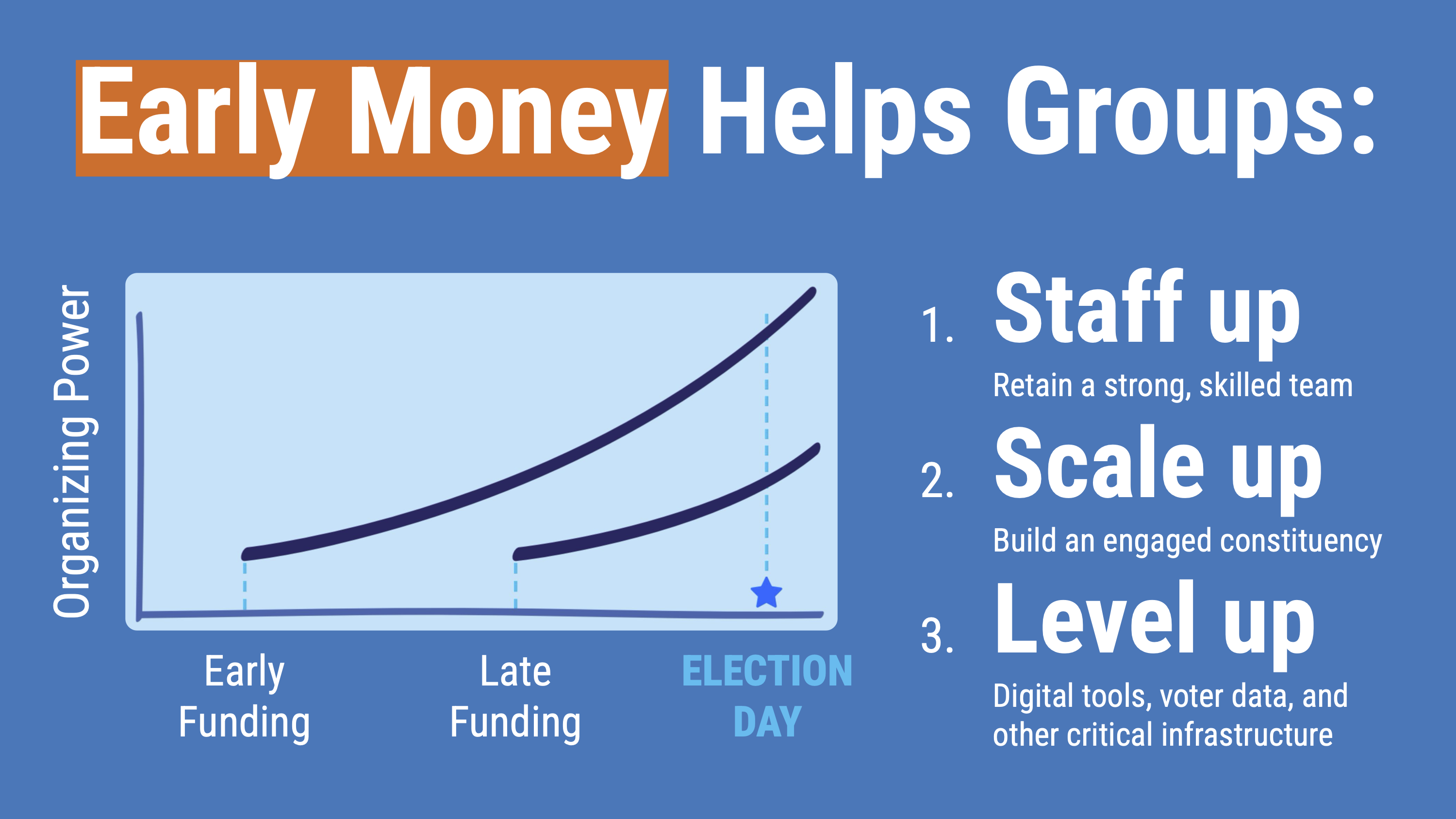
Every dollar today yields more votes than a dollar closer to Election Day.
Step 1: Take the Early Giving Pledge
We’ve written at length about the power of early investment, but it all comes down to this:
Earlier dollars generate more votes.
If you ask any progressive organization, they’ll tell you they are used to seeing an incredible spike in donations 1-2 months before a presidential election. This is great, except that by then it’s too late to hire experienced organizers, build a robust field operation, and put in place the infrastructure to identify, persuade, and mobilize every last voter.
What we’re seeking is nothing short of a sea change in political giving. It’s time for all of us to stop undercutting our own interests by giving late, when giving the same amount months earlier would take us so much further.
MVP has launched an Early Giving Pledge to give donors a very concrete, tangible way to declare their intention to give big and give early – and to call on our networks to do the same.
Sign the Early Giving Pledge here:
movement.vote/pledge
Step 2: Make Your Biggest Investment Ever
It’s time to get specific and make it happen. Talk to your spouse, your advisor – whoever you need to talk to! You don’t have to do this alone. If you already work with an MVP Philanthropic Advisor, reach out to them. If not, email advisor@movement.vote. We’re here to help.
Here are a few tips mentioned throughout the memo gathered in one place for your convenience:
Tip #1: A Stitch In Time Saves Nine.
Winning in 2024 will cost a lot of money. But not winning will cost infinitely more.
The harm already being done to our core democratic norms and institutions — and to the environment on which all life depends — is like a kind of volcanic activity that operates in an imperceptible, subterranean way until it explodes at the surface. Think: January 6th insurrection. Think: summer wildfires and deadly heat waves.
As you consider what constitutes your biggest investment ever, think of the 2024 elections as the core strategic intervention that makes all future interventions possible. Winning Democratic governance in November will not in and of itself be sufficient. But without it, we will be scrambling so much harder for years to come to achieve everything else we care about.
With it, so many wonderful things become possible!
Tip #2: Find Your “No-Regret Number.”
For each of us, there is a giving amount that represents doing everything in our power to stop authoritarianism and ensure a Blue Wave in November. This thought experiment might help you find it.
- Start by asking yourself: “What amount would be a genuine stretch?”
- Now, imagine waking up November 6th (the day after the elections) and we’ve lost by a narrow margin.
- Would you regret not giving more? If “no,” great. If “yes,” consider raising the amount.
- Repeat until your answer is: “I’d be devastated. But I would at least know I did all I could.”
Down Home North Carolina, getting out the vote in Granville County – November 2023
Tip #3: For Political Impact, Give Political Dollars.
As we shared in the Bat Signal memo, Americans donate $500 billion per year to charity. Only a fraction of that 501(c)3 giving goes to local voter engagement groups.
And, even that fraction far outweighs the 501(c)4 dollars — which can be used roughly 40% for political purposes like having explicit conversations with voters about the candidates and political parties — and PAC dollars, which can be used for 100% political purposes by local voter organizations that have C4s and PACs.
C3 giving is absolutely impactful. PAC giving is just far more impactful on electoral outcomes. MVP’s Senior State Strategy Advisor, Hallie Montoya Tansey, explains it like this:
“In the game of Taboo, players try to get their partners to guess the word on their card — without using the word itself.
Trying to get someone to vote with C3 money is like trying to communicate without being able to use the most obvious and important words to motivate action. PAC money allows us to tell them exactly what we hope they will do, and why.”
Simply put: With C3 money, organizers can talk about “saving democracy.” With PAC money, they can talk about “defeating Trump and MAGA Republicans” — up and down the ballot.
If we took even a small slice of overall 501(c)3 charitable giving and shifted it to hard-hitting c4 or PAC giving, many more organizers could tell voters exactly who to vote for and why.
Step 3: Spread the Word
The original Bat Signal memo had multi-million dollar ripple effects, because people shared it with their friends, families, colleagues, and professional networks — who then shared it with theirs.
The stories in this memo show that, when you share something out into your network, you simply never know who your message will reach and spur into action.
When in doubt, start small.
Here are a few things you can do:
Action #1: Share this Memo
Your own words and experiences are always the best. But here is a simple version of a message you can use or put in your own words:
I just read this important piece on the 2024 elections, and I want to share it. It lays out the stakes — and the need for all of us to make our biggest investments ever to defeat Trump, stop the MAGA movement, and ensure a Blue Wave. Let me know if you get a chance to read it and want to discuss! https://movement.vote/batsignal2
Action #2: Host a Small Gathering
Get a couple of people to host a small gathering or Zoom event with you. Go through your contacts and invite your networks. It can be really easy!
Share what is motivating you to give your biggest investment ever. Encourage others to do the same. Share MVP’s 2024 Strategy and discuss. And reach out if you need help.
The biggest thing we all need to do is get together with other people we know. And invite each other, inspire each other, and support each other to “go big” together.
It’s the simplest thing, but it works. Get together, talk, take action. Rinse and repeat!
We are here to help!
The MVP team and I are happy to do Zoom salons and get-togethers with as many people as you like. Small groups, large groups, your family, your book group – whoever it may be.
Let us know if you want to meet up, hop on a call, or schedule a Zoom salon – it’s an easy way to get the ball rolling!
* * * *
That’s it! Thank you for reading all the way to the end :). We are excited to hear about how your holiday conversations go. If we do this right, we can meet our baseline goals within the first couple of months, and spend the rest of the year focused on expanding the pie and winning. And if we do that right, we can spend the next four years, from 2025-2028, passing historic legislation and figuring out how to make things better and better and better.
Thank you for everything you have already done and for being with us on this journey of a lifetime.
Gooooooooo team!
Bat Signal 2: The Biggest Investment Ever was a collaborative effort – written by Billy Wimsatt and co-written by Zo Tobi with major editing by Rachel Gordon, Betty Herschman, Catherine Jampel, and feedback from many people including Ulysses Lateiner, Irene Yen, Haley Bash, Ryan Blitstein, Ruth Grant, Andrew Bundy, Micky McKinley, Robert Lowe, Michelle Berlin-Lowe, Chad Jones, Ann Fleck-Henderson, Jake Matilsky, Wendy Chavkin, Carrie Cuthbert, Linda Sargent, Marianne Rutter, Ken Olum, Francis Peter Frances, Suzy Myers, Larry Hott, Ryan Blitstein, Anne Nugent, Paula Wolk, and the MVP team – although Billy is solely responsible for its content.
Want posts emailed to your inbox?
Subscribe to our Substack:
